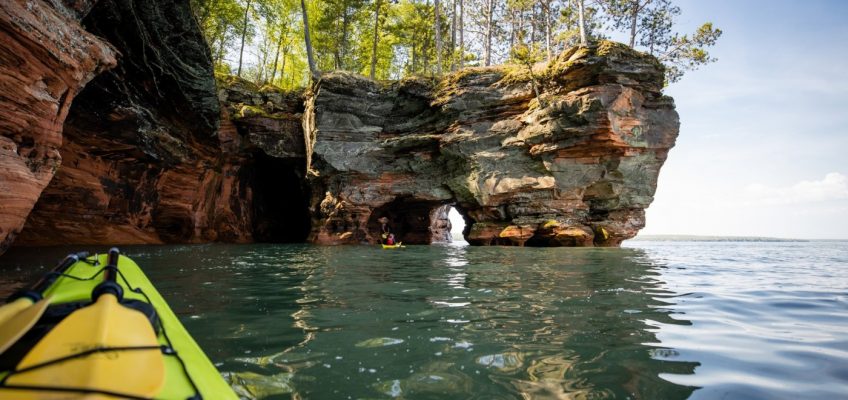Patti Nickell | Tribune News Service (TNS)
MADELINE ISLAND, Wis. — England’s ancient Arthurian legend is alive and well in northern Wisconsin, albeit with a slight twist.
Those who read Le Morte d’Arthur by 16th century author Sir Thomas Malory will remember that it was prophesied King Arthur, armed with his mighty sword Excalibur, would return from the isle of Avalon at the hour of Britain’s greatest need.
The Isle of Avalon, a mythical spot in the southwest of England, is a long way from the Apostle Islands off the shore of Lake Superior. Every year, thousands of visitors flock to the 22 islands that make up Apostle Islands National Lakeshore to admire the unusual formations of craggy rocks sculpted by nature into a labyrinth of caves, delicate arches and vaulted chambers.
But it’s a safe bet that many of them are unfamiliar with the Ojibwe legend that tribal elders buried sacred scrolls somewhere inside the network of caves that would elude discovery by all but a little boy – who would presumably return one day to guide his people.
I learned the legend from Ojibwe tribal member Mike Wiggins, site director of the Madeline Island Museum, a fascinating repository of artifacts celebrating all the cultures (Ojibwe, French, English and American) who have called this largest of the Apostle Islands home.
An ambitious two-year museum exhibition, “Passages: Ojibwe Migration to the Place Where the Food Grows on the Water,” chronicles the tribe’s journey through the eyes of their ancestors.
Related Articles
Regional US airports are back after years of decay
Is now a good time to visit Hawaii?
New Six Flags all-access pass lets people into all 42 parks
Speak easy? The ups and downs of travel translation apps
What are hush trips? The secret workcations everyone’s whispering about
After getting a thorough introduction to the region by Wiggins, I went by boat to see the chiseled formations of Devil’s Island with their honeycomb of caves but, alas, found nothing to indicate the scrolls’ whereabouts.
Madeline Island Museum is only one of the 11 sites managed by the Wisconsin Historical Society.
These sites range from the first to be established (1954), Villa Louis, a fur-trader’s mansion in Prairie du Chien, to the newest addition, Black Point Estate and Gardens in Lake Geneva, a Chicago beer baron’s mansion brought under the Historical Society umbrella in 2005.
I wasn’t able to get to Villa Louis, but I did make it to Black Point, and the adage “getting there is half the fun” was never more true.
The only way for most people to get there is by boat (they do have alternate arrangements for disabled guests; you’ll soon learn why), and the 90-minute round-trip cruise took me past the palatial summer homes of early Chicago titans of industry.
When he built Black Point in 1888, Conrad Seipp wanted a private retreat where he could relax with his family. He discouraged “drop-ins” by erecting it atop a forested hill, where a determined visitor must make his/her way from the boat dock up a winding staircase of 120 steps.
It’s worth the huffing and puffing. The 8,000-square-foot mansion is a fine example of Queen Anne/Victorian-style architecture. The interior is equally impressive with features such as stained-glass windows and an exquisite blue tiled fireplace in the sitting room.
And going down is much easier than the climb up.
Wisconsin’s Williamsburg
The third stop on my historical tour was Old World Wisconsin, a collection of structures moved from their original locations throughout the state to the 600-acre site in the community of Eagle.
Adjacent to the Kettle Moraine State Forest, Old World Wisconsin was begun as part of America’s Bicentennial Project in 1976.
You’ll need comfortable shoes as touring more than 60 structures depicting 19th century rural life in the nation’s heartland requires a lot of walking.
Costumed interpreters invite visitors to shake hands with history in buildings such as Four Mile Inn, built in 1853 as a stagecoach stop and tavern; the 1876 general store which once sold everything from bolts of cloth to gunpowder (today’s visitors will have to settle for gunpowder tea), and the one-room 1900 Raspberry Schoolhouse, which, ironically was built in 1896 and could be mistaken for a “Little House on the Prairie” set.
You can learn how to make coffeecake from a recipe dating to 1883; watch a weaver at her loom at the Pomeranian Immigrant Farm, and learn the heritage of Pomeranian, Hessian, German, Scandinavian and African-American settlers in their respective villages.
You need an entire day to thoroughly explore Wisconsin’s version of Colonial Williamsburg.
History doesn’t stop here
Wisconsin is serious about its history as witness plans for the opening of the state-of-the-art History Center in the capital city of Madison in 2027. But who says history has to be just events from the distant past?
If you book a stay at the 4-Star Grand Geneva Resort & Spa, you’ll find activities ranging from golf on two championship courses to a full-service spa and elegant dining in both the Geneva Chophouse and Ristorante Brissago.
What you won’t find is much evidence — except for the hidden bunny logo across from the Chophouse — that the Grand Geneva now occupies what was the first Playboy Club Resort in the United States.
If you’re looking for history with a hot meal, you’ll do no better than the Duck Inn Supper Club outside Lake Geneva in the town of Delavan.
Originally built in 1920 during Prohibition, guests had to covertly “duck in” and “speak easy” to avoid detection from government officials. A trap door (still in existence) led to a basement where gambling and drinking went on, and rumor has it that Al Capone, who owned a property on Lake Geneva, was a frequent visitor.
Go ahead and order a Brandy Old-Fashioned, Wisconsin’s official state cocktail. No one will prohibit you these days.
A view of the town of Bayfield, Wisconsin, from Bayfield Harbor. The walkable town is chock full of galleries, shops and one-of-a-kind restaurants. (Sigrid Knutson/Provided photo/TNS)
OK … enough history
Even the most interesting history requires the occasional break. You’ll find no better spot to chill than the lakeside town of Bayfield, the gateway to Madeline Island. This walkable town is chock full of galleries, shops and one-of-a-kind restaurants such as the St. James Social.
Located in a newly opened boutique hotel, it lives up to its name. The art-filled lobby/restaurant, described by the owners as a social lounge, is the place to mix and mingle.
The chef’s menu, which changes weekly, offers a selection of small plates, artisan pizzas, entrees and desserts.
Passages Exhibit at Madeline Island Museum, which is a fascinating repository of artifacts celebrating all the cultures (Ojibwe, French, English and American) who have called this largest of the Apostle Islands home. (Courtesy Wisconsin Historical Society/TNS)
If you’re looking for unique lodging, no place compares to Queen’s View Bed-and-Breakfast.
Filled to the brim with antiques and collectibles, the Queen Anne-style house was built in 1892 and has a lovely porch overlooking the gardens and plunge pool, with a bird’s eye view of Lake Superior on the horizon.
You’ll feel like you’re spending “a night at the museum,” and you’ll enjoy the antics of the “assistant manager” Coco Bean, a feisty Shih Tzu/bichon mix.
With today’s move toward more authentic travel experiences, a venture into heartland history could be just the ticket.
For more information, go to wisconsinhistory.org or travelwisconsin.com.
©2024 Tribune Content Agency, LLC.




